Financial Decision Making Report: Panini plc Accounting & Finance
VerifiedAdded on 2023/06/10
|11
|3138
|468
Report
AI Summary
This report delves into the financial decision-making processes of Panini plc, examining the crucial roles of the accounting and finance departments. It explores various sources of finance essential for business growth and expansion, including loans, crowdfunding, and credit facilities. The core of the report lies in a detailed ratio analysis, evaluating Panini plc's financial performance using key metrics such as gross profit margin, operating profit margin, return on capital employed, current ratio, quick ratio, and inventory turnover ratio. The analysis compares the financial performance of Panini plc over two years, 2018 and 2019, providing insights into the company's efficiency, profitability, and liquidity. The report highlights the significance of each ratio and its implications for the company's financial health and strategic decision-making.

FINANCIAL
DECISION MAKING
DECISION MAKING
Paraphrase This Document
Need a fresh take? Get an instant paraphrase of this document with our AI Paraphraser
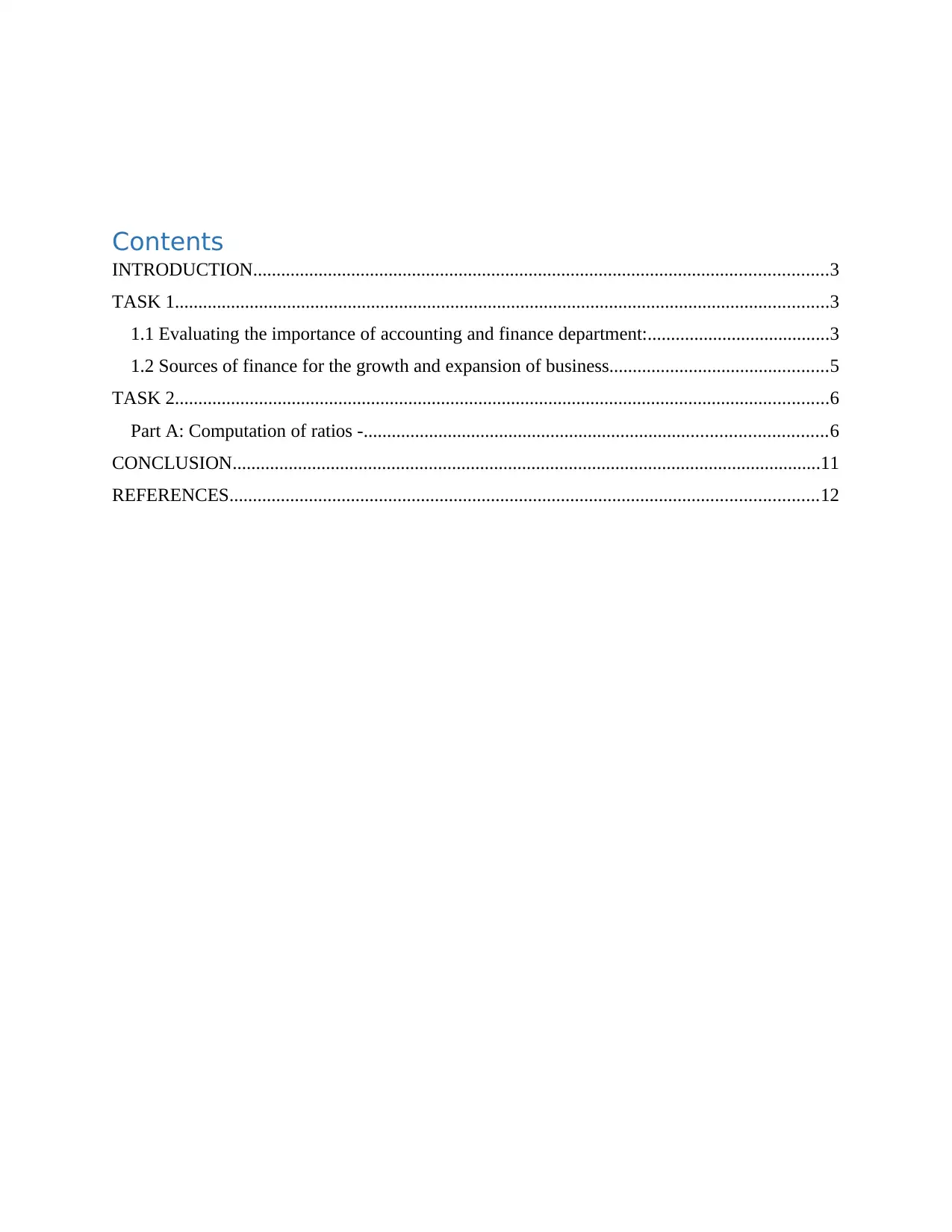
Contents
INTRODUCTION...........................................................................................................................3
TASK 1............................................................................................................................................3
1.1 Evaluating the importance of accounting and finance department:.......................................3
1.2 Sources of finance for the growth and expansion of business...............................................5
TASK 2............................................................................................................................................6
Part A: Computation of ratios -...................................................................................................6
CONCLUSION..............................................................................................................................11
REFERENCES..............................................................................................................................12
INTRODUCTION...........................................................................................................................3
TASK 1............................................................................................................................................3
1.1 Evaluating the importance of accounting and finance department:.......................................3
1.2 Sources of finance for the growth and expansion of business...............................................5
TASK 2............................................................................................................................................6
Part A: Computation of ratios -...................................................................................................6
CONCLUSION..............................................................................................................................11
REFERENCES..............................................................................................................................12
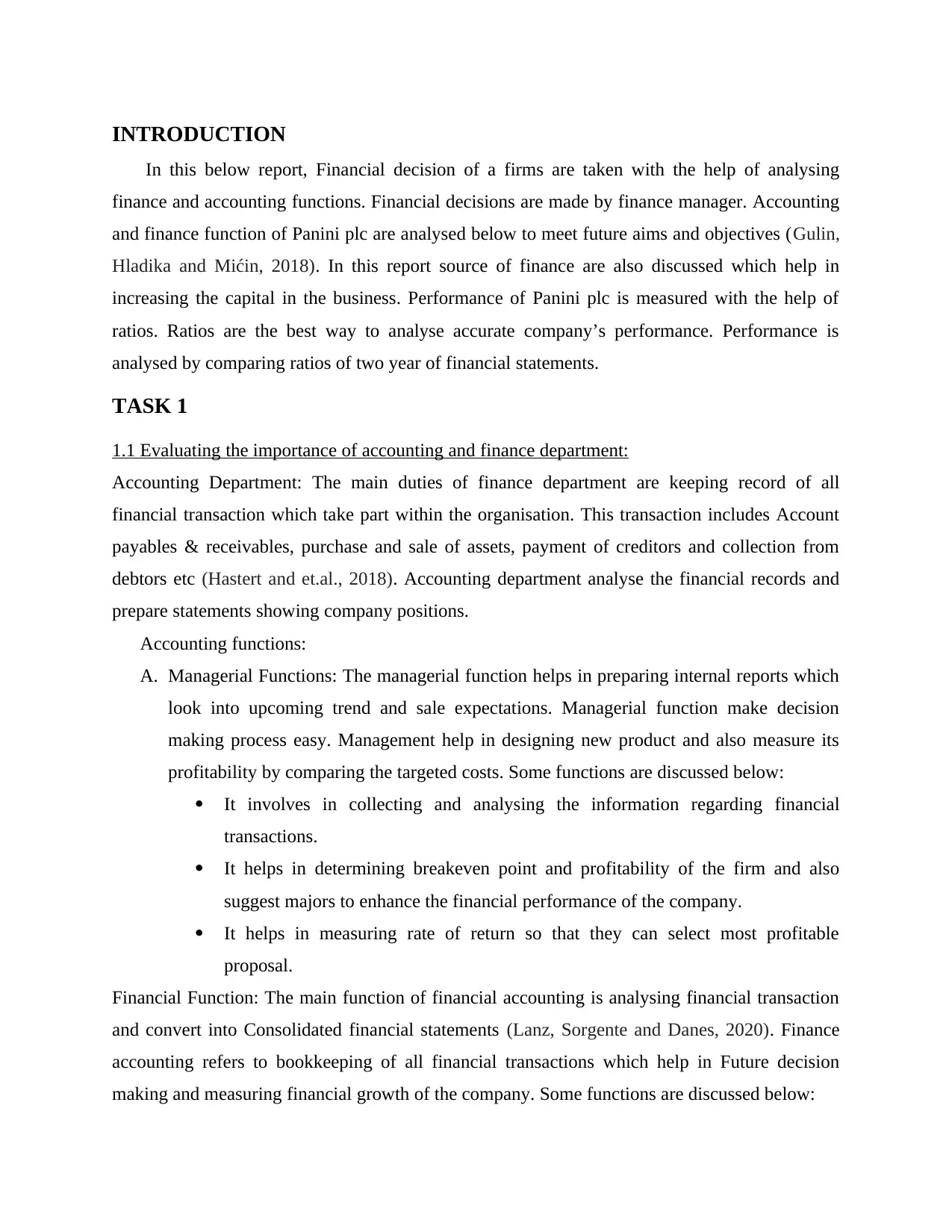
INTRODUCTION
In this below report, Financial decision of a firms are taken with the help of analysing
finance and accounting functions. Financial decisions are made by finance manager. Accounting
and finance function of Panini plc are analysed below to meet future aims and objectives (Gulin,
Hladika and Mićin, 2018). In this report source of finance are also discussed which help in
increasing the capital in the business. Performance of Panini plc is measured with the help of
ratios. Ratios are the best way to analyse accurate company’s performance. Performance is
analysed by comparing ratios of two year of financial statements.
TASK 1
1.1 Evaluating the importance of accounting and finance department:
Accounting Department: The main duties of finance department are keeping record of all
financial transaction which take part within the organisation. This transaction includes Account
payables & receivables, purchase and sale of assets, payment of creditors and collection from
debtors etc (Hastert and et.al., 2018). Accounting department analyse the financial records and
prepare statements showing company positions.
Accounting functions:
A. Managerial Functions: The managerial function helps in preparing internal reports which
look into upcoming trend and sale expectations. Managerial function make decision
making process easy. Management help in designing new product and also measure its
profitability by comparing the targeted costs. Some functions are discussed below:
It involves in collecting and analysing the information regarding financial
transactions.
It helps in determining breakeven point and profitability of the firm and also
suggest majors to enhance the financial performance of the company.
It helps in measuring rate of return so that they can select most profitable
proposal.
Financial Function: The main function of financial accounting is analysing financial transaction
and convert into Consolidated financial statements (Lanz, Sorgente and Danes, 2020). Finance
accounting refers to bookkeeping of all financial transactions which help in Future decision
making and measuring financial growth of the company. Some functions are discussed below:
In this below report, Financial decision of a firms are taken with the help of analysing
finance and accounting functions. Financial decisions are made by finance manager. Accounting
and finance function of Panini plc are analysed below to meet future aims and objectives (Gulin,
Hladika and Mićin, 2018). In this report source of finance are also discussed which help in
increasing the capital in the business. Performance of Panini plc is measured with the help of
ratios. Ratios are the best way to analyse accurate company’s performance. Performance is
analysed by comparing ratios of two year of financial statements.
TASK 1
1.1 Evaluating the importance of accounting and finance department:
Accounting Department: The main duties of finance department are keeping record of all
financial transaction which take part within the organisation. This transaction includes Account
payables & receivables, purchase and sale of assets, payment of creditors and collection from
debtors etc (Hastert and et.al., 2018). Accounting department analyse the financial records and
prepare statements showing company positions.
Accounting functions:
A. Managerial Functions: The managerial function helps in preparing internal reports which
look into upcoming trend and sale expectations. Managerial function make decision
making process easy. Management help in designing new product and also measure its
profitability by comparing the targeted costs. Some functions are discussed below:
It involves in collecting and analysing the information regarding financial
transactions.
It helps in determining breakeven point and profitability of the firm and also
suggest majors to enhance the financial performance of the company.
It helps in measuring rate of return so that they can select most profitable
proposal.
Financial Function: The main function of financial accounting is analysing financial transaction
and convert into Consolidated financial statements (Lanz, Sorgente and Danes, 2020). Finance
accounting refers to bookkeeping of all financial transactions which help in Future decision
making and measuring financial growth of the company. Some functions are discussed below:
⊘ This is a preview!⊘
Do you want full access?
Subscribe today to unlock all pages.

Trusted by 1+ million students worldwide
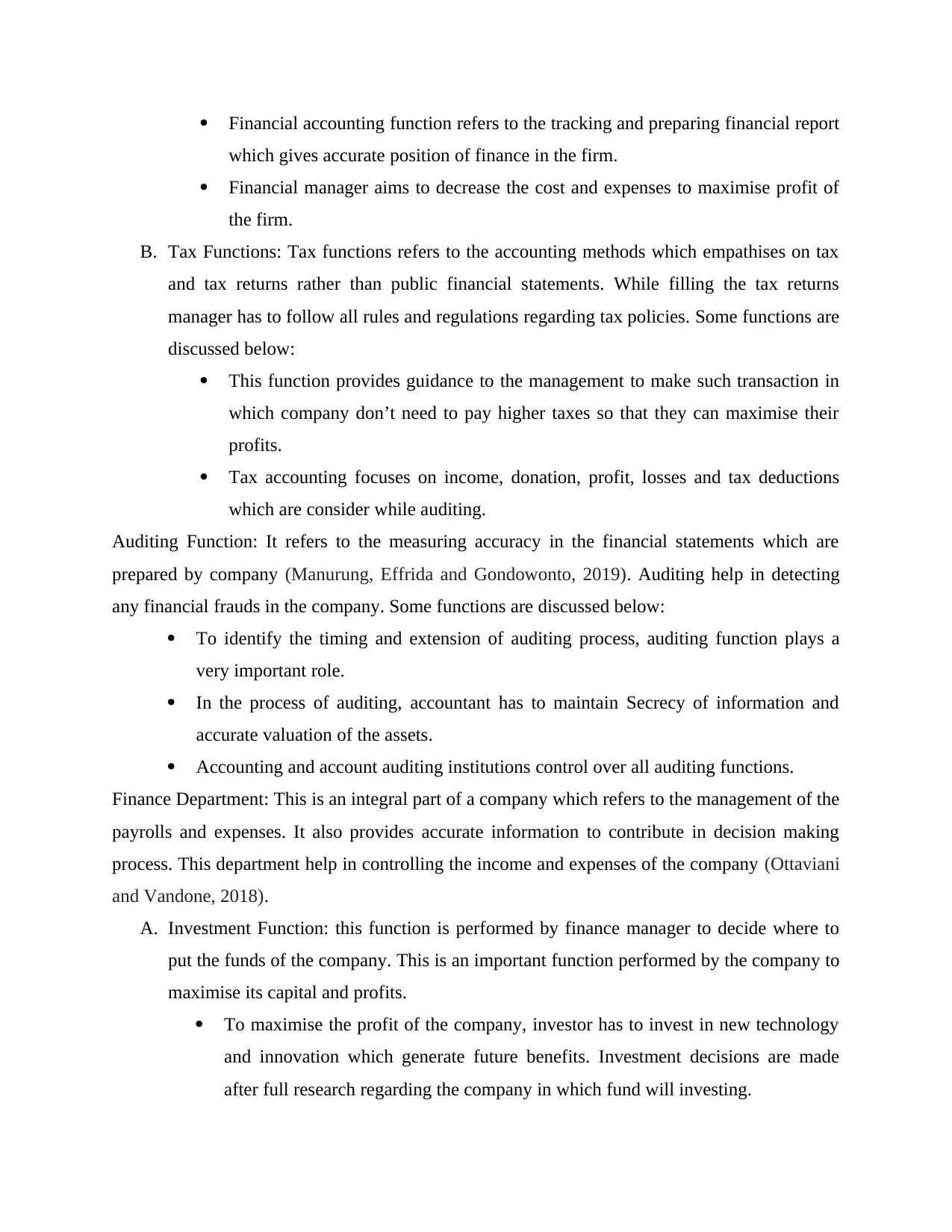
Financial accounting function refers to the tracking and preparing financial report
which gives accurate position of finance in the firm.
Financial manager aims to decrease the cost and expenses to maximise profit of
the firm.
B. Tax Functions: Tax functions refers to the accounting methods which empathises on tax
and tax returns rather than public financial statements. While filling the tax returns
manager has to follow all rules and regulations regarding tax policies. Some functions are
discussed below:
This function provides guidance to the management to make such transaction in
which company don’t need to pay higher taxes so that they can maximise their
profits.
Tax accounting focuses on income, donation, profit, losses and tax deductions
which are consider while auditing.
Auditing Function: It refers to the measuring accuracy in the financial statements which are
prepared by company (Manurung, Effrida and Gondowonto, 2019). Auditing help in detecting
any financial frauds in the company. Some functions are discussed below:
To identify the timing and extension of auditing process, auditing function plays a
very important role.
In the process of auditing, accountant has to maintain Secrecy of information and
accurate valuation of the assets.
Accounting and account auditing institutions control over all auditing functions.
Finance Department: This is an integral part of a company which refers to the management of the
payrolls and expenses. It also provides accurate information to contribute in decision making
process. This department help in controlling the income and expenses of the company (Ottaviani
and Vandone, 2018).
A. Investment Function: this function is performed by finance manager to decide where to
put the funds of the company. This is an important function performed by the company to
maximise its capital and profits.
To maximise the profit of the company, investor has to invest in new technology
and innovation which generate future benefits. Investment decisions are made
after full research regarding the company in which fund will investing.
which gives accurate position of finance in the firm.
Financial manager aims to decrease the cost and expenses to maximise profit of
the firm.
B. Tax Functions: Tax functions refers to the accounting methods which empathises on tax
and tax returns rather than public financial statements. While filling the tax returns
manager has to follow all rules and regulations regarding tax policies. Some functions are
discussed below:
This function provides guidance to the management to make such transaction in
which company don’t need to pay higher taxes so that they can maximise their
profits.
Tax accounting focuses on income, donation, profit, losses and tax deductions
which are consider while auditing.
Auditing Function: It refers to the measuring accuracy in the financial statements which are
prepared by company (Manurung, Effrida and Gondowonto, 2019). Auditing help in detecting
any financial frauds in the company. Some functions are discussed below:
To identify the timing and extension of auditing process, auditing function plays a
very important role.
In the process of auditing, accountant has to maintain Secrecy of information and
accurate valuation of the assets.
Accounting and account auditing institutions control over all auditing functions.
Finance Department: This is an integral part of a company which refers to the management of the
payrolls and expenses. It also provides accurate information to contribute in decision making
process. This department help in controlling the income and expenses of the company (Ottaviani
and Vandone, 2018).
A. Investment Function: this function is performed by finance manager to decide where to
put the funds of the company. This is an important function performed by the company to
maximise its capital and profits.
To maximise the profit of the company, investor has to invest in new technology
and innovation which generate future benefits. Investment decisions are made
after full research regarding the company in which fund will investing.
Paraphrase This Document
Need a fresh take? Get an instant paraphrase of this document with our AI Paraphraser
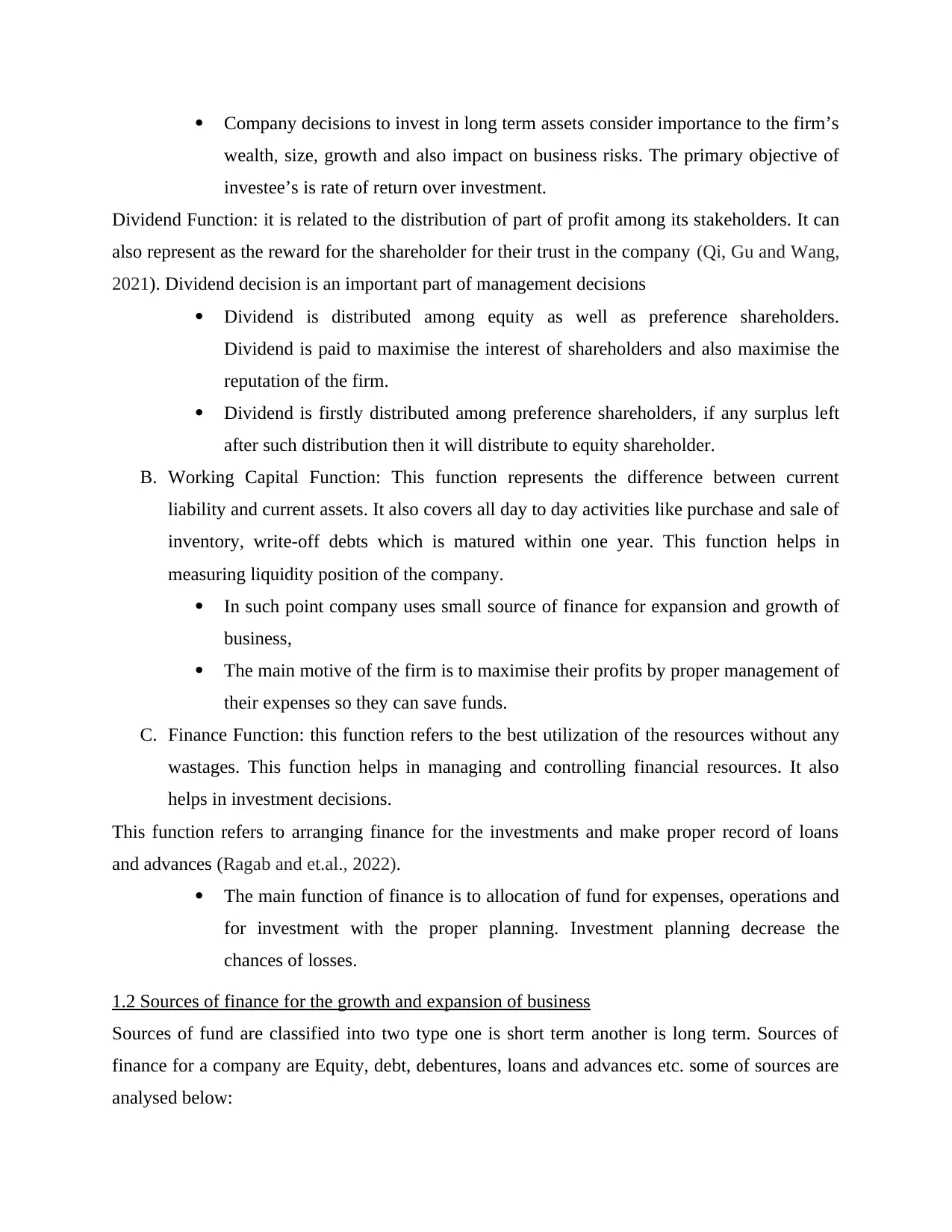
Company decisions to invest in long term assets consider importance to the firm’s
wealth, size, growth and also impact on business risks. The primary objective of
investee’s is rate of return over investment.
Dividend Function: it is related to the distribution of part of profit among its stakeholders. It can
also represent as the reward for the shareholder for their trust in the company (Qi, Gu and Wang,
2021). Dividend decision is an important part of management decisions
Dividend is distributed among equity as well as preference shareholders.
Dividend is paid to maximise the interest of shareholders and also maximise the
reputation of the firm.
Dividend is firstly distributed among preference shareholders, if any surplus left
after such distribution then it will distribute to equity shareholder.
B. Working Capital Function: This function represents the difference between current
liability and current assets. It also covers all day to day activities like purchase and sale of
inventory, write-off debts which is matured within one year. This function helps in
measuring liquidity position of the company.
In such point company uses small source of finance for expansion and growth of
business,
The main motive of the firm is to maximise their profits by proper management of
their expenses so they can save funds.
C. Finance Function: this function refers to the best utilization of the resources without any
wastages. This function helps in managing and controlling financial resources. It also
helps in investment decisions.
This function refers to arranging finance for the investments and make proper record of loans
and advances (Ragab and et.al., 2022).
The main function of finance is to allocation of fund for expenses, operations and
for investment with the proper planning. Investment planning decrease the
chances of losses.
1.2 Sources of finance for the growth and expansion of business
Sources of fund are classified into two type one is short term another is long term. Sources of
finance for a company are Equity, debt, debentures, loans and advances etc. some of sources are
analysed below:
wealth, size, growth and also impact on business risks. The primary objective of
investee’s is rate of return over investment.
Dividend Function: it is related to the distribution of part of profit among its stakeholders. It can
also represent as the reward for the shareholder for their trust in the company (Qi, Gu and Wang,
2021). Dividend decision is an important part of management decisions
Dividend is distributed among equity as well as preference shareholders.
Dividend is paid to maximise the interest of shareholders and also maximise the
reputation of the firm.
Dividend is firstly distributed among preference shareholders, if any surplus left
after such distribution then it will distribute to equity shareholder.
B. Working Capital Function: This function represents the difference between current
liability and current assets. It also covers all day to day activities like purchase and sale of
inventory, write-off debts which is matured within one year. This function helps in
measuring liquidity position of the company.
In such point company uses small source of finance for expansion and growth of
business,
The main motive of the firm is to maximise their profits by proper management of
their expenses so they can save funds.
C. Finance Function: this function refers to the best utilization of the resources without any
wastages. This function helps in managing and controlling financial resources. It also
helps in investment decisions.
This function refers to arranging finance for the investments and make proper record of loans
and advances (Ragab and et.al., 2022).
The main function of finance is to allocation of fund for expenses, operations and
for investment with the proper planning. Investment planning decrease the
chances of losses.
1.2 Sources of finance for the growth and expansion of business
Sources of fund are classified into two type one is short term another is long term. Sources of
finance for a company are Equity, debt, debentures, loans and advances etc. some of sources are
analysed below:
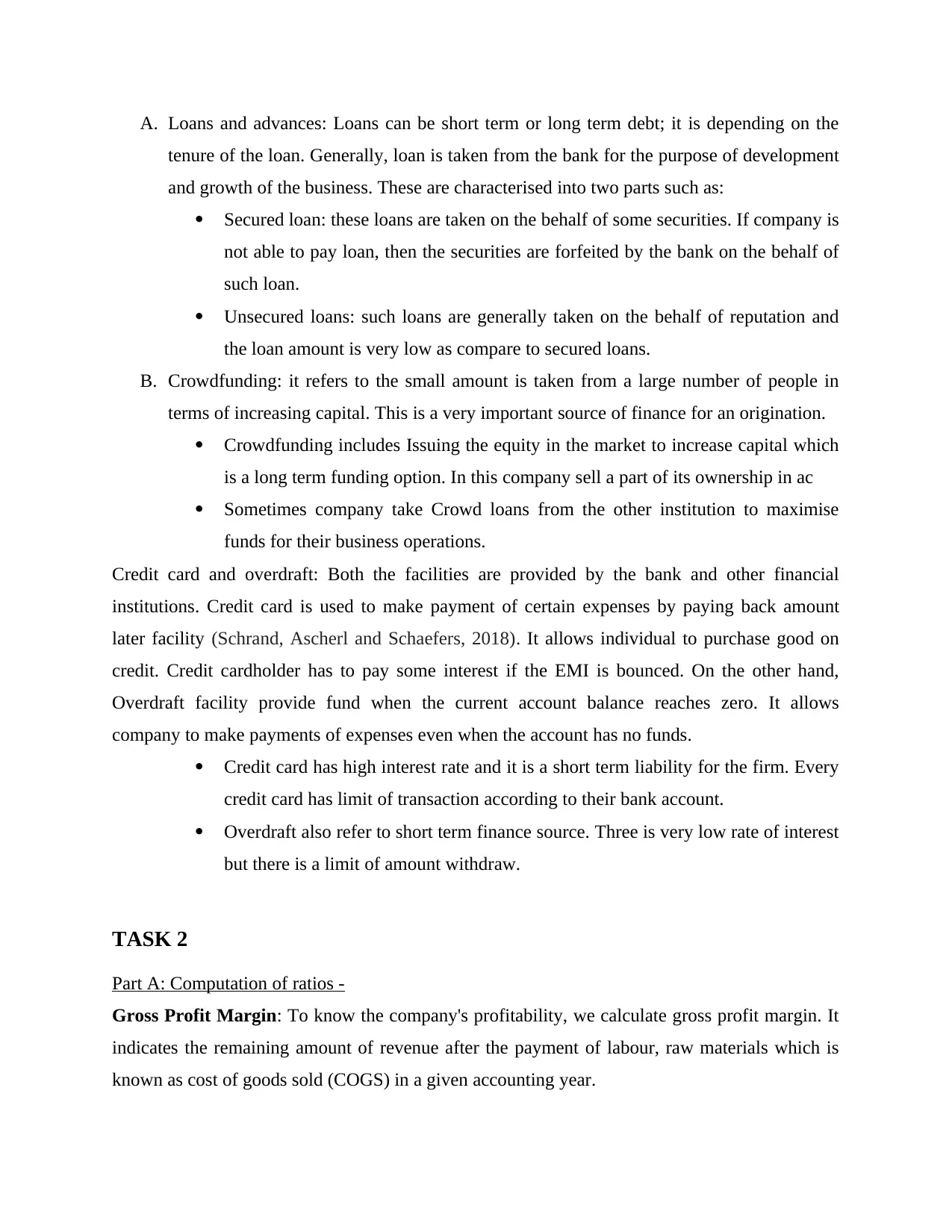
A. Loans and advances: Loans can be short term or long term debt; it is depending on the
tenure of the loan. Generally, loan is taken from the bank for the purpose of development
and growth of the business. These are characterised into two parts such as:
Secured loan: these loans are taken on the behalf of some securities. If company is
not able to pay loan, then the securities are forfeited by the bank on the behalf of
such loan.
Unsecured loans: such loans are generally taken on the behalf of reputation and
the loan amount is very low as compare to secured loans.
B. Crowdfunding: it refers to the small amount is taken from a large number of people in
terms of increasing capital. This is a very important source of finance for an origination.
Crowdfunding includes Issuing the equity in the market to increase capital which
is a long term funding option. In this company sell a part of its ownership in ac
Sometimes company take Crowd loans from the other institution to maximise
funds for their business operations.
Credit card and overdraft: Both the facilities are provided by the bank and other financial
institutions. Credit card is used to make payment of certain expenses by paying back amount
later facility (Schrand, Ascherl and Schaefers, 2018). It allows individual to purchase good on
credit. Credit cardholder has to pay some interest if the EMI is bounced. On the other hand,
Overdraft facility provide fund when the current account balance reaches zero. It allows
company to make payments of expenses even when the account has no funds.
Credit card has high interest rate and it is a short term liability for the firm. Every
credit card has limit of transaction according to their bank account.
Overdraft also refer to short term finance source. Three is very low rate of interest
but there is a limit of amount withdraw.
TASK 2
Part A: Computation of ratios -
Gross Profit Margin: To know the company's profitability, we calculate gross profit margin. It
indicates the remaining amount of revenue after the payment of labour, raw materials which is
known as cost of goods sold (COGS) in a given accounting year.
tenure of the loan. Generally, loan is taken from the bank for the purpose of development
and growth of the business. These are characterised into two parts such as:
Secured loan: these loans are taken on the behalf of some securities. If company is
not able to pay loan, then the securities are forfeited by the bank on the behalf of
such loan.
Unsecured loans: such loans are generally taken on the behalf of reputation and
the loan amount is very low as compare to secured loans.
B. Crowdfunding: it refers to the small amount is taken from a large number of people in
terms of increasing capital. This is a very important source of finance for an origination.
Crowdfunding includes Issuing the equity in the market to increase capital which
is a long term funding option. In this company sell a part of its ownership in ac
Sometimes company take Crowd loans from the other institution to maximise
funds for their business operations.
Credit card and overdraft: Both the facilities are provided by the bank and other financial
institutions. Credit card is used to make payment of certain expenses by paying back amount
later facility (Schrand, Ascherl and Schaefers, 2018). It allows individual to purchase good on
credit. Credit cardholder has to pay some interest if the EMI is bounced. On the other hand,
Overdraft facility provide fund when the current account balance reaches zero. It allows
company to make payments of expenses even when the account has no funds.
Credit card has high interest rate and it is a short term liability for the firm. Every
credit card has limit of transaction according to their bank account.
Overdraft also refer to short term finance source. Three is very low rate of interest
but there is a limit of amount withdraw.
TASK 2
Part A: Computation of ratios -
Gross Profit Margin: To know the company's profitability, we calculate gross profit margin. It
indicates the remaining amount of revenue after the payment of labour, raw materials which is
known as cost of goods sold (COGS) in a given accounting year.
⊘ This is a preview!⊘
Do you want full access?
Subscribe today to unlock all pages.

Trusted by 1+ million students worldwide
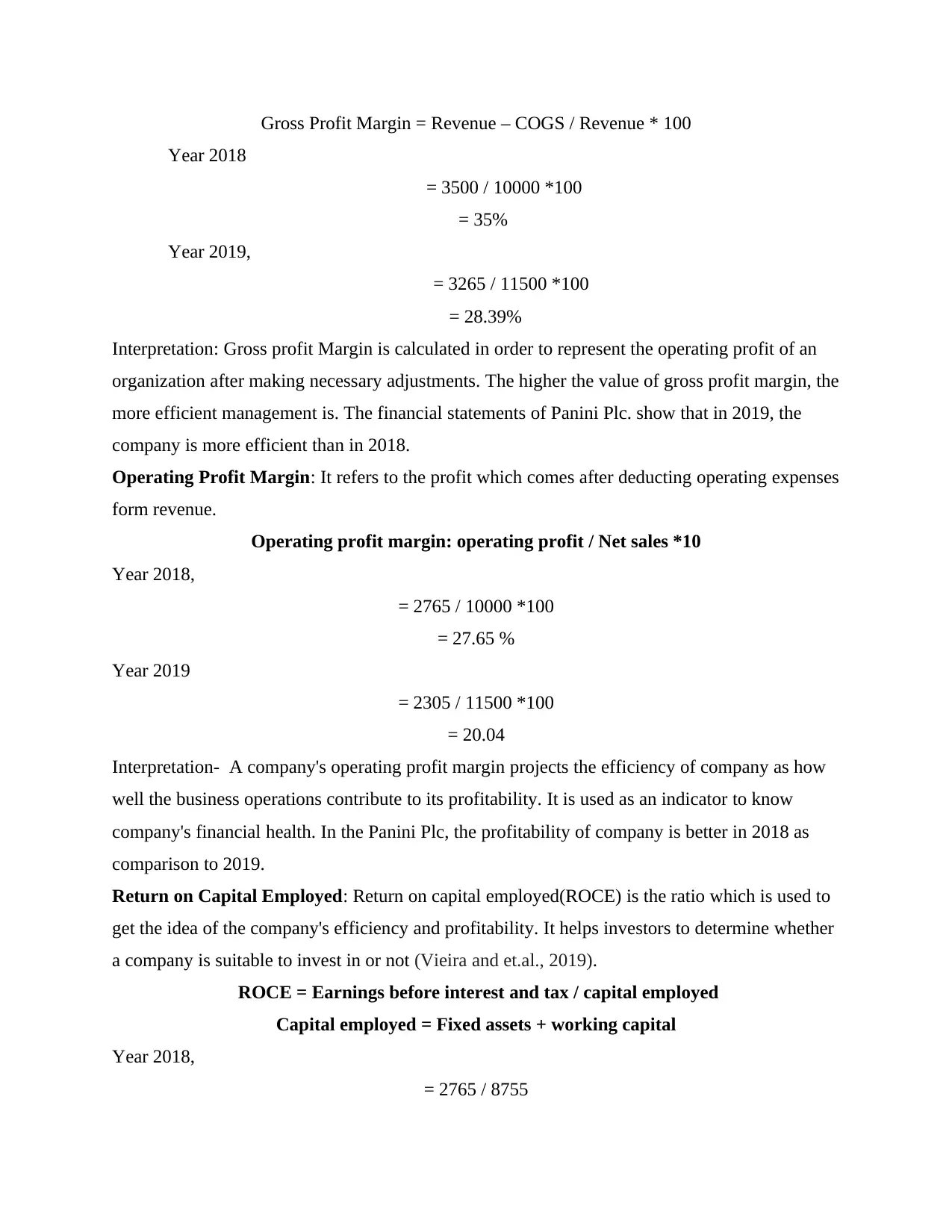
Gross Profit Margin = Revenue – COGS / Revenue * 100
Year 2018
= 3500 / 10000 *100
= 35%
Year 2019,
= 3265 / 11500 *100
= 28.39%
Interpretation: Gross profit Margin is calculated in order to represent the operating profit of an
organization after making necessary adjustments. The higher the value of gross profit margin, the
more efficient management is. The financial statements of Panini Plc. show that in 2019, the
company is more efficient than in 2018.
Operating Profit Margin: It refers to the profit which comes after deducting operating expenses
form revenue.
Operating profit margin: operating profit / Net sales *10
Year 2018,
= 2765 / 10000 *100
= 27.65 %
Year 2019
= 2305 / 11500 *100
= 20.04
Interpretation- A company's operating profit margin projects the efficiency of company as how
well the business operations contribute to its profitability. It is used as an indicator to know
company's financial health. In the Panini Plc, the profitability of company is better in 2018 as
comparison to 2019.
Return on Capital Employed: Return on capital employed(ROCE) is the ratio which is used to
get the idea of the company's efficiency and profitability. It helps investors to determine whether
a company is suitable to invest in or not (Vieira and et.al., 2019).
ROCE = Earnings before interest and tax / capital employed
Capital employed = Fixed assets + working capital
Year 2018,
= 2765 / 8755
Year 2018
= 3500 / 10000 *100
= 35%
Year 2019,
= 3265 / 11500 *100
= 28.39%
Interpretation: Gross profit Margin is calculated in order to represent the operating profit of an
organization after making necessary adjustments. The higher the value of gross profit margin, the
more efficient management is. The financial statements of Panini Plc. show that in 2019, the
company is more efficient than in 2018.
Operating Profit Margin: It refers to the profit which comes after deducting operating expenses
form revenue.
Operating profit margin: operating profit / Net sales *10
Year 2018,
= 2765 / 10000 *100
= 27.65 %
Year 2019
= 2305 / 11500 *100
= 20.04
Interpretation- A company's operating profit margin projects the efficiency of company as how
well the business operations contribute to its profitability. It is used as an indicator to know
company's financial health. In the Panini Plc, the profitability of company is better in 2018 as
comparison to 2019.
Return on Capital Employed: Return on capital employed(ROCE) is the ratio which is used to
get the idea of the company's efficiency and profitability. It helps investors to determine whether
a company is suitable to invest in or not (Vieira and et.al., 2019).
ROCE = Earnings before interest and tax / capital employed
Capital employed = Fixed assets + working capital
Year 2018,
= 2765 / 8755
Paraphrase This Document
Need a fresh take? Get an instant paraphrase of this document with our AI Paraphraser
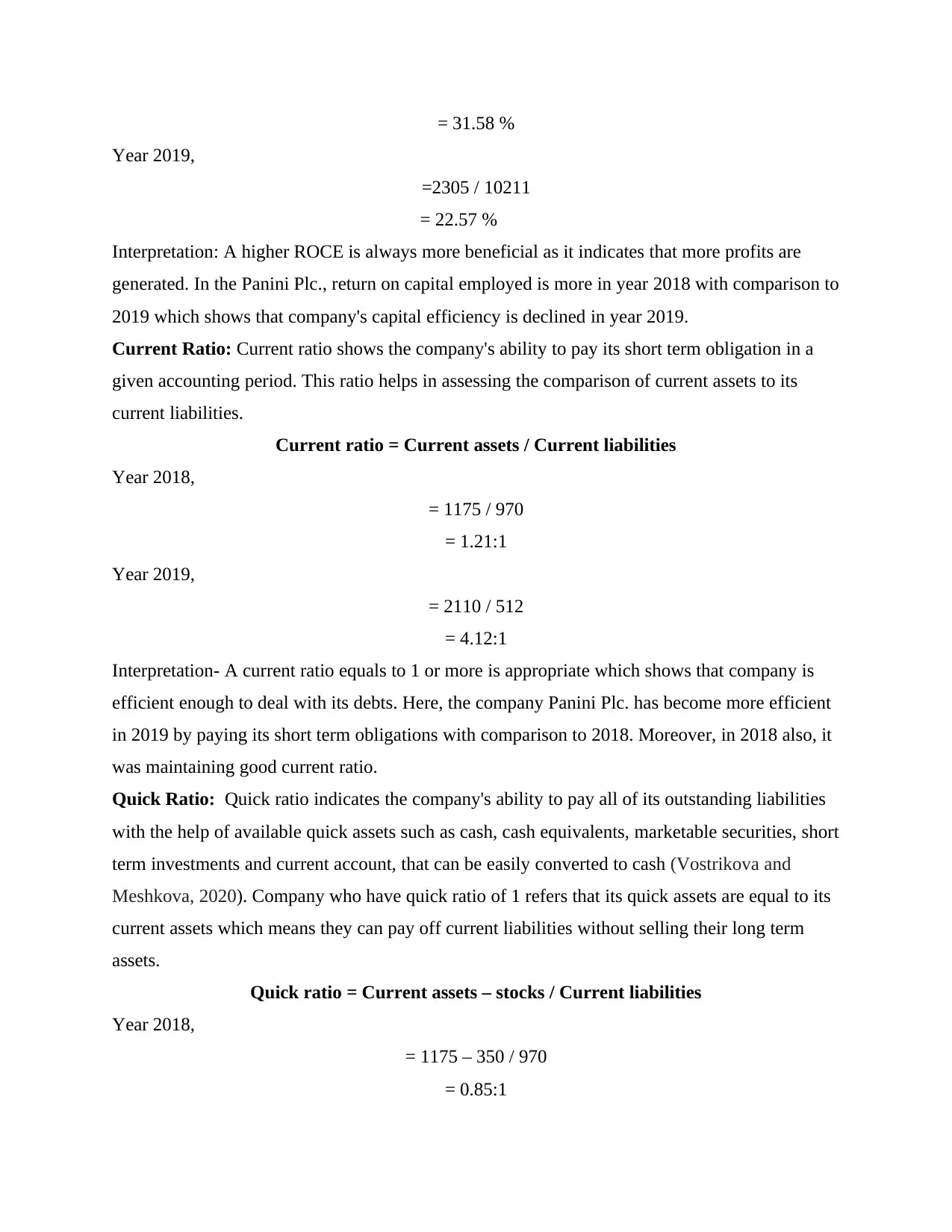
= 31.58 %
Year 2019,
=2305 / 10211
= 22.57 %
Interpretation: A higher ROCE is always more beneficial as it indicates that more profits are
generated. In the Panini Plc., return on capital employed is more in year 2018 with comparison to
2019 which shows that company's capital efficiency is declined in year 2019.
Current Ratio: Current ratio shows the company's ability to pay its short term obligation in a
given accounting period. This ratio helps in assessing the comparison of current assets to its
current liabilities.
Current ratio = Current assets / Current liabilities
Year 2018,
= 1175 / 970
= 1.21:1
Year 2019,
= 2110 / 512
= 4.12:1
Interpretation- A current ratio equals to 1 or more is appropriate which shows that company is
efficient enough to deal with its debts. Here, the company Panini Plc. has become more efficient
in 2019 by paying its short term obligations with comparison to 2018. Moreover, in 2018 also, it
was maintaining good current ratio.
Quick Ratio: Quick ratio indicates the company's ability to pay all of its outstanding liabilities
with the help of available quick assets such as cash, cash equivalents, marketable securities, short
term investments and current account, that can be easily converted to cash (Vostrikova and
Meshkova, 2020). Company who have quick ratio of 1 refers that its quick assets are equal to its
current assets which means they can pay off current liabilities without selling their long term
assets.
Quick ratio = Current assets – stocks / Current liabilities
Year 2018,
= 1175 – 350 / 970
= 0.85:1
Year 2019,
=2305 / 10211
= 22.57 %
Interpretation: A higher ROCE is always more beneficial as it indicates that more profits are
generated. In the Panini Plc., return on capital employed is more in year 2018 with comparison to
2019 which shows that company's capital efficiency is declined in year 2019.
Current Ratio: Current ratio shows the company's ability to pay its short term obligation in a
given accounting period. This ratio helps in assessing the comparison of current assets to its
current liabilities.
Current ratio = Current assets / Current liabilities
Year 2018,
= 1175 / 970
= 1.21:1
Year 2019,
= 2110 / 512
= 4.12:1
Interpretation- A current ratio equals to 1 or more is appropriate which shows that company is
efficient enough to deal with its debts. Here, the company Panini Plc. has become more efficient
in 2019 by paying its short term obligations with comparison to 2018. Moreover, in 2018 also, it
was maintaining good current ratio.
Quick Ratio: Quick ratio indicates the company's ability to pay all of its outstanding liabilities
with the help of available quick assets such as cash, cash equivalents, marketable securities, short
term investments and current account, that can be easily converted to cash (Vostrikova and
Meshkova, 2020). Company who have quick ratio of 1 refers that its quick assets are equal to its
current assets which means they can pay off current liabilities without selling their long term
assets.
Quick ratio = Current assets – stocks / Current liabilities
Year 2018,
= 1175 – 350 / 970
= 0.85:1
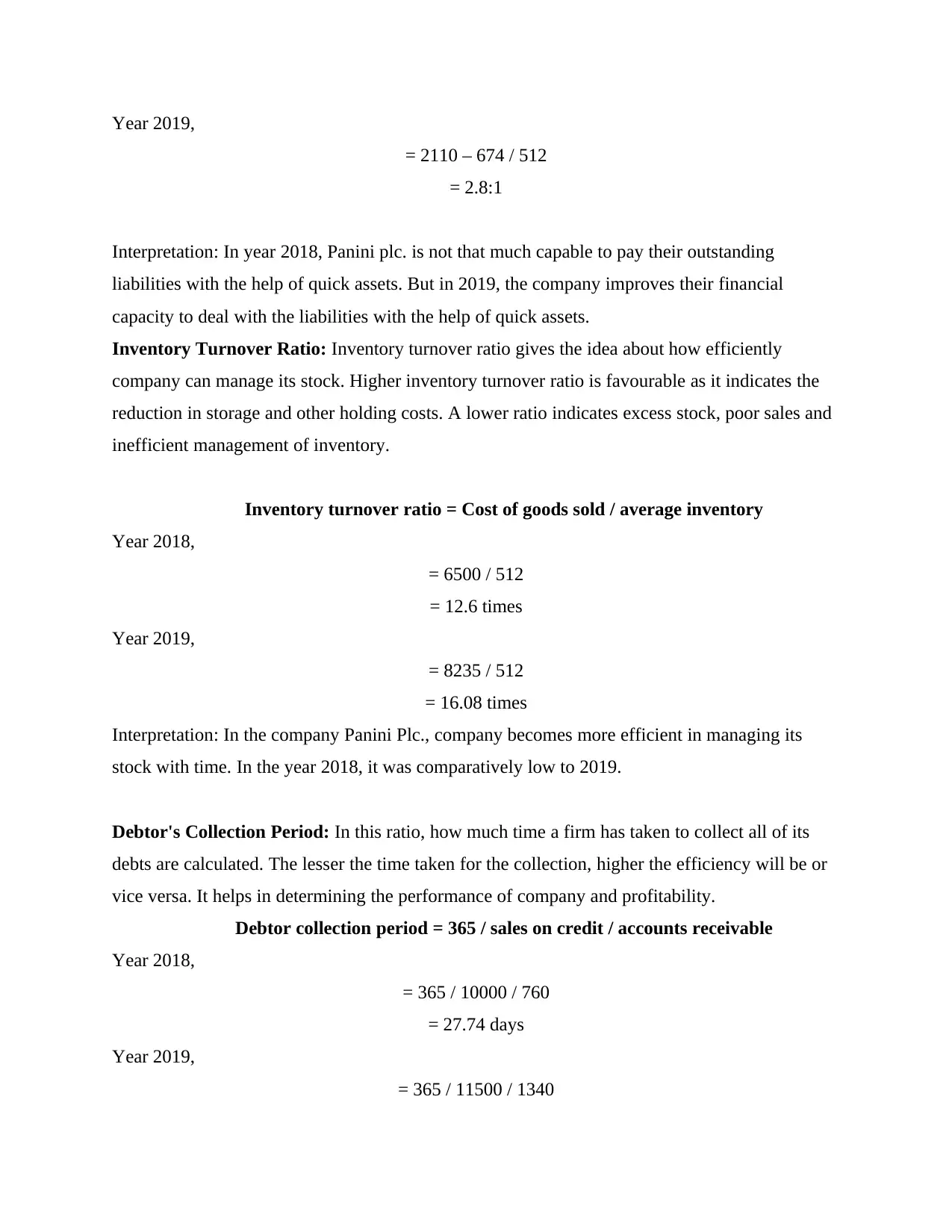
Year 2019,
= 2110 – 674 / 512
= 2.8:1
Interpretation: In year 2018, Panini plc. is not that much capable to pay their outstanding
liabilities with the help of quick assets. But in 2019, the company improves their financial
capacity to deal with the liabilities with the help of quick assets.
Inventory Turnover Ratio: Inventory turnover ratio gives the idea about how efficiently
company can manage its stock. Higher inventory turnover ratio is favourable as it indicates the
reduction in storage and other holding costs. A lower ratio indicates excess stock, poor sales and
inefficient management of inventory.
Inventory turnover ratio = Cost of goods sold / average inventory
Year 2018,
= 6500 / 512
= 12.6 times
Year 2019,
= 8235 / 512
= 16.08 times
Interpretation: In the company Panini Plc., company becomes more efficient in managing its
stock with time. In the year 2018, it was comparatively low to 2019.
Debtor's Collection Period: In this ratio, how much time a firm has taken to collect all of its
debts are calculated. The lesser the time taken for the collection, higher the efficiency will be or
vice versa. It helps in determining the performance of company and profitability.
Debtor collection period = 365 / sales on credit / accounts receivable
Year 2018,
= 365 / 10000 / 760
= 27.74 days
Year 2019,
= 365 / 11500 / 1340
= 2110 – 674 / 512
= 2.8:1
Interpretation: In year 2018, Panini plc. is not that much capable to pay their outstanding
liabilities with the help of quick assets. But in 2019, the company improves their financial
capacity to deal with the liabilities with the help of quick assets.
Inventory Turnover Ratio: Inventory turnover ratio gives the idea about how efficiently
company can manage its stock. Higher inventory turnover ratio is favourable as it indicates the
reduction in storage and other holding costs. A lower ratio indicates excess stock, poor sales and
inefficient management of inventory.
Inventory turnover ratio = Cost of goods sold / average inventory
Year 2018,
= 6500 / 512
= 12.6 times
Year 2019,
= 8235 / 512
= 16.08 times
Interpretation: In the company Panini Plc., company becomes more efficient in managing its
stock with time. In the year 2018, it was comparatively low to 2019.
Debtor's Collection Period: In this ratio, how much time a firm has taken to collect all of its
debts are calculated. The lesser the time taken for the collection, higher the efficiency will be or
vice versa. It helps in determining the performance of company and profitability.
Debtor collection period = 365 / sales on credit / accounts receivable
Year 2018,
= 365 / 10000 / 760
= 27.74 days
Year 2019,
= 365 / 11500 / 1340
⊘ This is a preview!⊘
Do you want full access?
Subscribe today to unlock all pages.

Trusted by 1+ million students worldwide
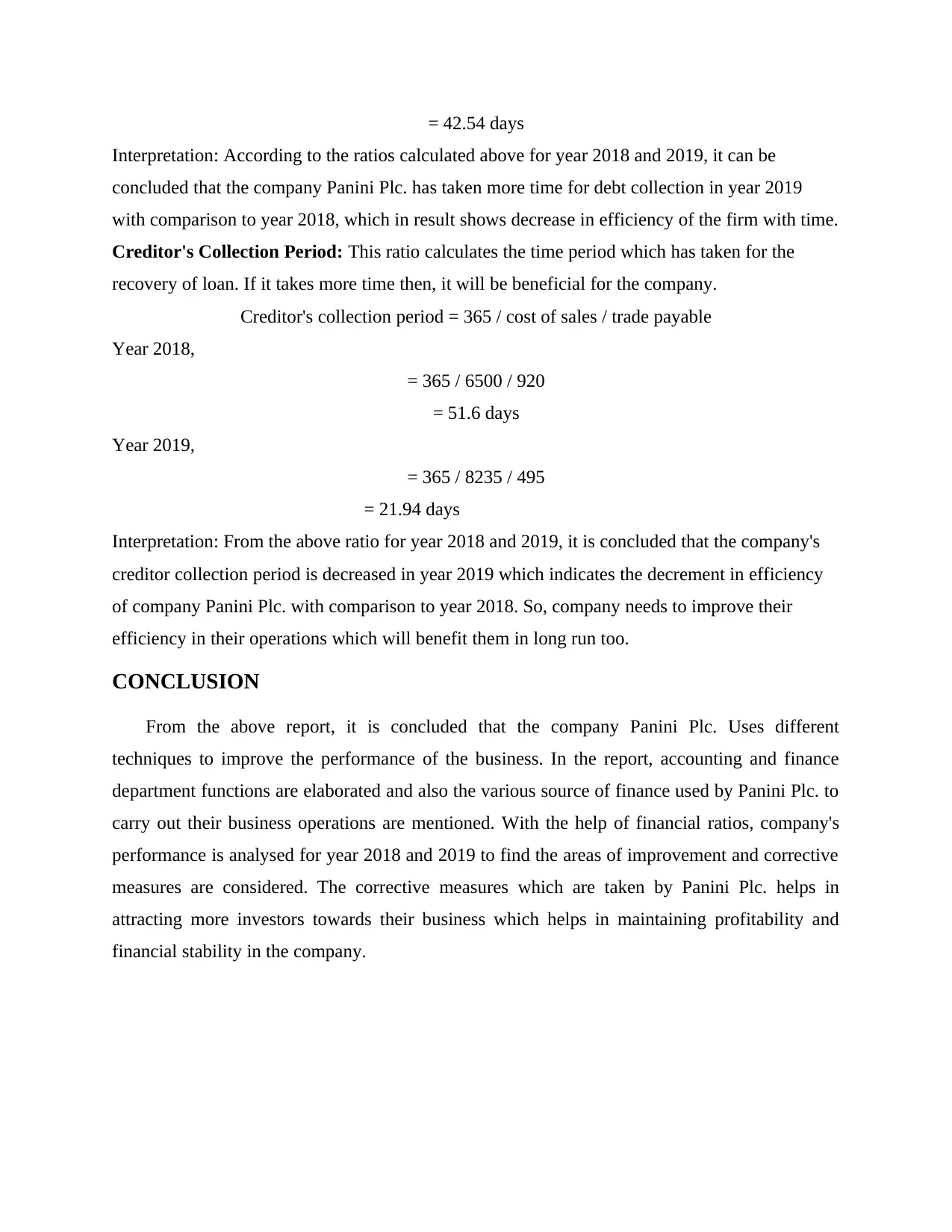
= 42.54 days
Interpretation: According to the ratios calculated above for year 2018 and 2019, it can be
concluded that the company Panini Plc. has taken more time for debt collection in year 2019
with comparison to year 2018, which in result shows decrease in efficiency of the firm with time.
Creditor's Collection Period: This ratio calculates the time period which has taken for the
recovery of loan. If it takes more time then, it will be beneficial for the company.
Creditor's collection period = 365 / cost of sales / trade payable
Year 2018,
= 365 / 6500 / 920
= 51.6 days
Year 2019,
= 365 / 8235 / 495
= 21.94 days
Interpretation: From the above ratio for year 2018 and 2019, it is concluded that the company's
creditor collection period is decreased in year 2019 which indicates the decrement in efficiency
of company Panini Plc. with comparison to year 2018. So, company needs to improve their
efficiency in their operations which will benefit them in long run too.
CONCLUSION
From the above report, it is concluded that the company Panini Plc. Uses different
techniques to improve the performance of the business. In the report, accounting and finance
department functions are elaborated and also the various source of finance used by Panini Plc. to
carry out their business operations are mentioned. With the help of financial ratios, company's
performance is analysed for year 2018 and 2019 to find the areas of improvement and corrective
measures are considered. The corrective measures which are taken by Panini Plc. helps in
attracting more investors towards their business which helps in maintaining profitability and
financial stability in the company.
Interpretation: According to the ratios calculated above for year 2018 and 2019, it can be
concluded that the company Panini Plc. has taken more time for debt collection in year 2019
with comparison to year 2018, which in result shows decrease in efficiency of the firm with time.
Creditor's Collection Period: This ratio calculates the time period which has taken for the
recovery of loan. If it takes more time then, it will be beneficial for the company.
Creditor's collection period = 365 / cost of sales / trade payable
Year 2018,
= 365 / 6500 / 920
= 51.6 days
Year 2019,
= 365 / 8235 / 495
= 21.94 days
Interpretation: From the above ratio for year 2018 and 2019, it is concluded that the company's
creditor collection period is decreased in year 2019 which indicates the decrement in efficiency
of company Panini Plc. with comparison to year 2018. So, company needs to improve their
efficiency in their operations which will benefit them in long run too.
CONCLUSION
From the above report, it is concluded that the company Panini Plc. Uses different
techniques to improve the performance of the business. In the report, accounting and finance
department functions are elaborated and also the various source of finance used by Panini Plc. to
carry out their business operations are mentioned. With the help of financial ratios, company's
performance is analysed for year 2018 and 2019 to find the areas of improvement and corrective
measures are considered. The corrective measures which are taken by Panini Plc. helps in
attracting more investors towards their business which helps in maintaining profitability and
financial stability in the company.
Paraphrase This Document
Need a fresh take? Get an instant paraphrase of this document with our AI Paraphraser
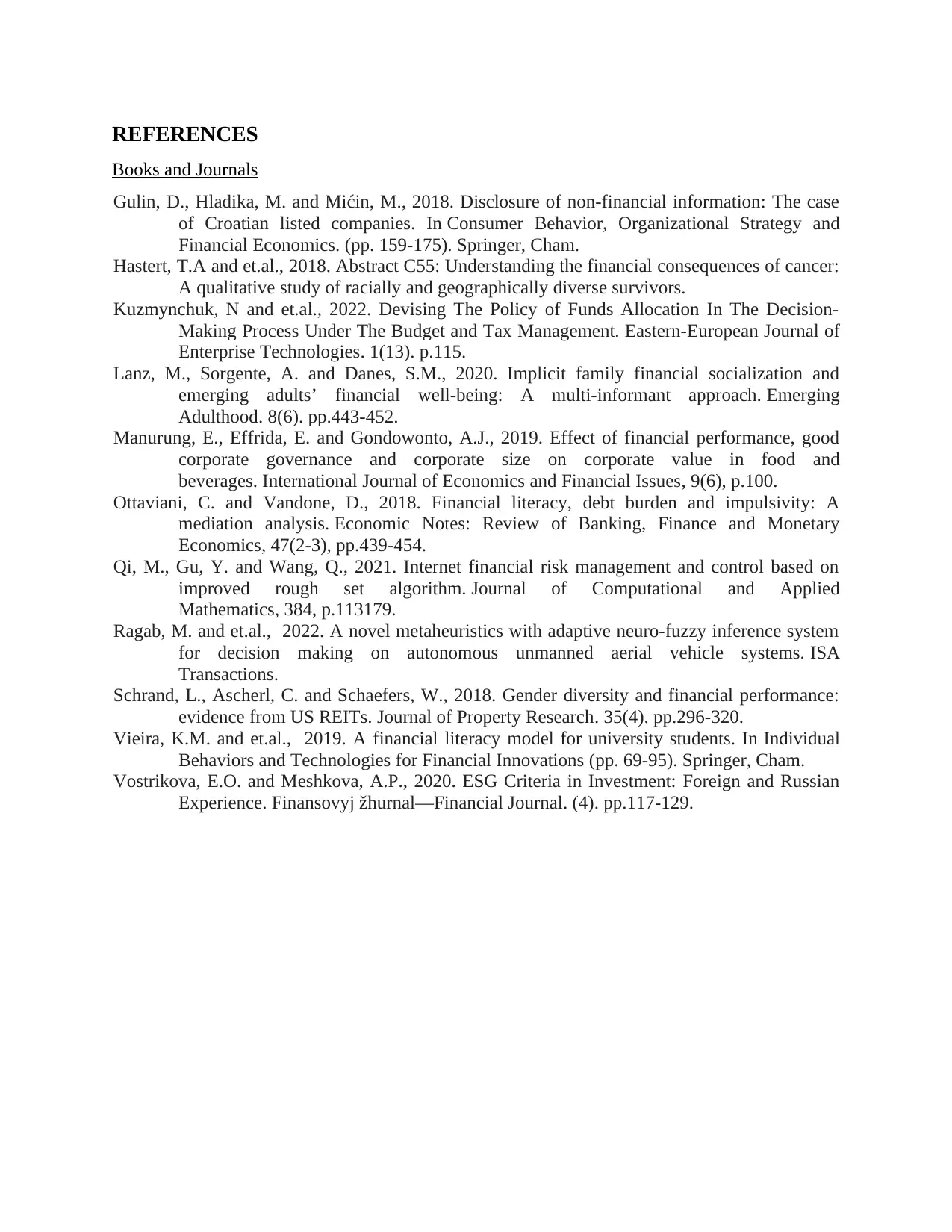
REFERENCES
Books and Journals
Gulin, D., Hladika, M. and Mićin, M., 2018. Disclosure of non-financial information: The case
of Croatian listed companies. In Consumer Behavior, Organizational Strategy and
Financial Economics. (pp. 159-175). Springer, Cham.
Hastert, T.A and et.al., 2018. Abstract C55: Understanding the financial consequences of cancer:
A qualitative study of racially and geographically diverse survivors.
Kuzmynchuk, N and et.al., 2022. Devising The Policy of Funds Allocation In The Decision-
Making Process Under The Budget and Tax Management. Eastern-European Journal of
Enterprise Technologies. 1(13). p.115.
Lanz, M., Sorgente, A. and Danes, S.M., 2020. Implicit family financial socialization and
emerging adults’ financial well-being: A multi-informant approach. Emerging
Adulthood. 8(6). pp.443-452.
Manurung, E., Effrida, E. and Gondowonto, A.J., 2019. Effect of financial performance, good
corporate governance and corporate size on corporate value in food and
beverages. International Journal of Economics and Financial Issues, 9(6), p.100.
Ottaviani, C. and Vandone, D., 2018. Financial literacy, debt burden and impulsivity: A
mediation analysis. Economic Notes: Review of Banking, Finance and Monetary
Economics, 47(2-3), pp.439-454.
Qi, M., Gu, Y. and Wang, Q., 2021. Internet financial risk management and control based on
improved rough set algorithm. Journal of Computational and Applied
Mathematics, 384, p.113179.
Ragab, M. and et.al., 2022. A novel metaheuristics with adaptive neuro-fuzzy inference system
for decision making on autonomous unmanned aerial vehicle systems. ISA
Transactions.
Schrand, L., Ascherl, C. and Schaefers, W., 2018. Gender diversity and financial performance:
evidence from US REITs. Journal of Property Research. 35(4). pp.296-320.
Vieira, K.M. and et.al., 2019. A financial literacy model for university students. In Individual
Behaviors and Technologies for Financial Innovations (pp. 69-95). Springer, Cham.
Vostrikova, E.O. and Meshkova, A.P., 2020. ESG Criteria in Investment: Foreign and Russian
Experience. Finansovyj žhurnal—Financial Journal. (4). pp.117-129.
Books and Journals
Gulin, D., Hladika, M. and Mićin, M., 2018. Disclosure of non-financial information: The case
of Croatian listed companies. In Consumer Behavior, Organizational Strategy and
Financial Economics. (pp. 159-175). Springer, Cham.
Hastert, T.A and et.al., 2018. Abstract C55: Understanding the financial consequences of cancer:
A qualitative study of racially and geographically diverse survivors.
Kuzmynchuk, N and et.al., 2022. Devising The Policy of Funds Allocation In The Decision-
Making Process Under The Budget and Tax Management. Eastern-European Journal of
Enterprise Technologies. 1(13). p.115.
Lanz, M., Sorgente, A. and Danes, S.M., 2020. Implicit family financial socialization and
emerging adults’ financial well-being: A multi-informant approach. Emerging
Adulthood. 8(6). pp.443-452.
Manurung, E., Effrida, E. and Gondowonto, A.J., 2019. Effect of financial performance, good
corporate governance and corporate size on corporate value in food and
beverages. International Journal of Economics and Financial Issues, 9(6), p.100.
Ottaviani, C. and Vandone, D., 2018. Financial literacy, debt burden and impulsivity: A
mediation analysis. Economic Notes: Review of Banking, Finance and Monetary
Economics, 47(2-3), pp.439-454.
Qi, M., Gu, Y. and Wang, Q., 2021. Internet financial risk management and control based on
improved rough set algorithm. Journal of Computational and Applied
Mathematics, 384, p.113179.
Ragab, M. and et.al., 2022. A novel metaheuristics with adaptive neuro-fuzzy inference system
for decision making on autonomous unmanned aerial vehicle systems. ISA
Transactions.
Schrand, L., Ascherl, C. and Schaefers, W., 2018. Gender diversity and financial performance:
evidence from US REITs. Journal of Property Research. 35(4). pp.296-320.
Vieira, K.M. and et.al., 2019. A financial literacy model for university students. In Individual
Behaviors and Technologies for Financial Innovations (pp. 69-95). Springer, Cham.
Vostrikova, E.O. and Meshkova, A.P., 2020. ESG Criteria in Investment: Foreign and Russian
Experience. Finansovyj žhurnal—Financial Journal. (4). pp.117-129.
1 out of 11
Related Documents
Your All-in-One AI-Powered Toolkit for Academic Success.
+13062052269
info@desklib.com
Available 24*7 on WhatsApp / Email
![[object Object]](/_next/static/media/star-bottom.7253800d.svg)
Unlock your academic potential
Copyright © 2020–2025 A2Z Services. All Rights Reserved. Developed and managed by ZUCOL.
